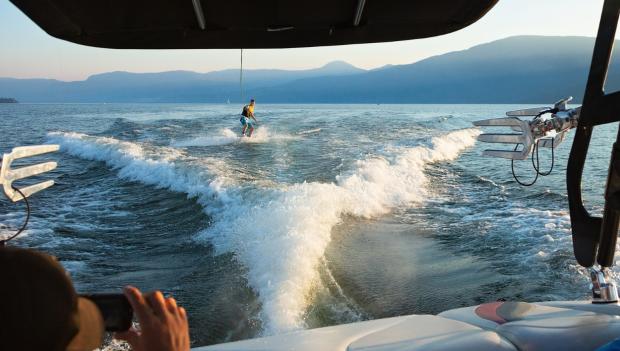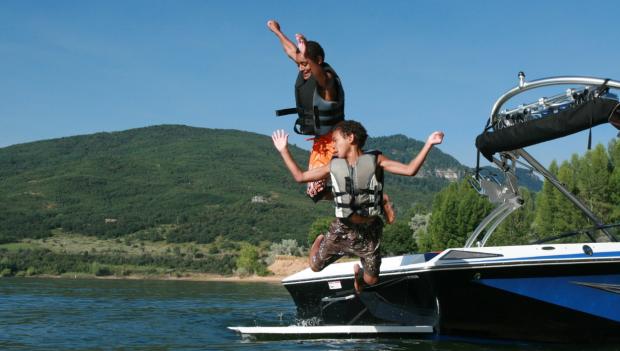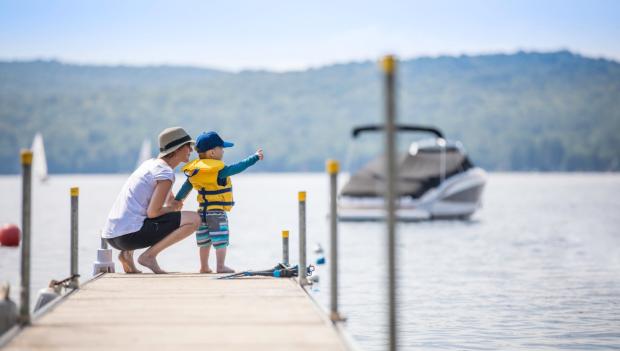
As summertime approaches, friends and family head to the lake for fun on the water. While those long lake days conjure up images of bathing suits, sunscreen, fishing and water skis, we can’t forget that a lovely lake day could quickly turn dangerous when safety isn’t top of mind. Keep your loved ones safe on the water by learning and following these important boating and water sports rules.
Make lake safety a priority with these 11 essential rules for boating and water sports.
1. Understand watercraft navigational lighting after dark.
While every state’s watercraft lighting rules may vary slightly, all states require watercraft (including boats, kayaks, canoes, etc.) to comply with certain lighting rules after dark. These lighting rules are generally in effect from dawn until dusk, and during periods of restricted visibility such as during fog or rain. Lighting requirements depend on the length of the watercraft but, generally speaking, powerboats are required to have sidelights, a masthead light and a stern light. Sailboats must have a sidelight and a stern light, and rowed or paddled boats must have a white light that can be displayed to avoid collision. Before heading out on the water, check the lighting requirements in your state.
2. Know the signs of drowning.
When many people think of drowning, they imagine the person in distress thrashing and flailing around in the water. In reality, drowning usually happens fast and silently. Signs of a person actively drowning include silence (children who are hyperventilating won’t be screaming for help), a head that is tilted back towards the sky as it searches for air, and arms that are moving downward as the drowning person attempts to push their bodies upwards on something solid that is not there. Distressed swimmers may be clinging to the side of a pool or raft, or treading or bobbing in the water.
3. Be on the lookout for navigational hazards.
When operating a boat, navigational hazards are not always what you expect them to be. While boating, stay on the lookout for, and give a wide berth to, piers, floating and shoreline docks, swim platforms, fixed platforms, boat lifts, mooring buoys, research related devices that may be floating in the water, regulatory markers and utility or irrigation piping. Doing so can help prevent a collision.
4. Stay hydrated and protect yourself from the sun.
On a hot summer day it’s possible to lose up to a liter of water an hour through sweating and evaporation. Dehydration can lead to symptoms such as headaches, leg cramps and dizziness, and severe dehydration can be serious and lead to unconsciousness. While enjoying your time on the water, don’t forget to hydrate, even if you don’t feel thirsty. It’s also necessary to protect yourself from the sun by wearing sunscreen, sunglasses and a wide brimmed hat, and by taking breaks in the shade.
5. Comply with all insurance rules, whether you own or rent your watercraft.
Before operating a boat you must make sure that you are complying with all insurance requirements, whether you own the boat or are just renting it for the day. Generally speaking, boats and personal watercrafts are required to carry either owner’s or operator’s liability insurance, with some exemptions depending on the type and size of the watercraft. Insurance requirements vary state by state, so check the local rules before hitting the water to avoid any potential fines.
6. Always wear a life jacket.
It can be tempting to ditch the life jacket, especially if you feel confident in your abilities as a swimmer. But even when a life jacket isn’t required, it’s a good idea to wear one. Accidents on the water cannot always be predicted or prevented, and even strong swimmers may unexpectedly find themselves in a dangerous situation. Federal regulations require that all children under 13 years of age wear a U.S. Coast Guard approved life jacket at all times while out on the water. Boats are also required to have U.S. Coast Guard approved life jackets for every person on board.

Recommended: 20 Essential Camping Safety Rules for Kids
7. Don’t go out on the water alone.
While alone time on the water can sound like the ultimate escape, one of the first rules of water safety is to never go out alone. Whether swimming, paddle boarding, kayaking, boating or diving, bringing along a buddy can help ensure your safety should you find yourself injured. If you do choose to go out on the water alone, let people know where you are going and when you expect to return home.
8. Know your hand signals when water skiing or tubing.
Water skiing and tubing while being towed by a boat is a fun and popular lake activity. But before your boat speeds off into the open waters pulling a skier behind it, make sure that everyone understands hand signals so that those on the boat can communicate with those on the water. Hand signals allow non-verbal communication (such as “get me back in the boat,” “I’m okay,” and “I’m done”) and can allow the person on the water to tell the boater to go faster or slower, or turn left or right.
9. Keep an eye on the weather patterns.
Everyone knows that a sunny summer day can quickly morph into an afternoon of thunderstorms in many regions across the country. It’s important to check the forecast before you hit the water, but even if that forecast is clear, continue to keep your eye on the skies. Thunderstorms can create dangerous wave and wind conditions, and a lightning strike to a vessel could be deadly. When it looks like thunderstorms may be developing, the responsible thing to do is to head back to shore.

Recommended: 13 Natural Water Parks You Need to See to Believe
10. When boating, assign someone to be the “spotter.”
It’s easy to get caught up in the social side of boating and forget that your vessel shares the lake with a number of other vessels and swimmers. To ensure that someone is always keeping an eye on the water, assign someone on your boat to be the official “spotter.” The job of the spotter is to keep an eye out for other people on the water and to alert the captain of the boat to any approaching hazards.
11. Take a water safety course before your camping trip.
Before lake season begins, sign the family up for a water safety course. This applies to boaters, jet skiers, kayakers and anyone that may find themselves in a situation that requires immediate response in an aquatic emergency. Taking a water safety course will ensure that everyone in your party is trained to respond should the unexpected happen while out on the lake.
Check with your Local Government Organization
Many policies have been established to counter and control the coronavirus outbreak. State and local officials have been taking decisive action to stop the spread. The policies vary by state, sometimes to a great degree. When you book a reservation, make sure to review the park and state’s latest rules and regulations prior to your visit.
For COVID-19 updates, please visit our Impacted Park List and Reservation Guide for the latest information.